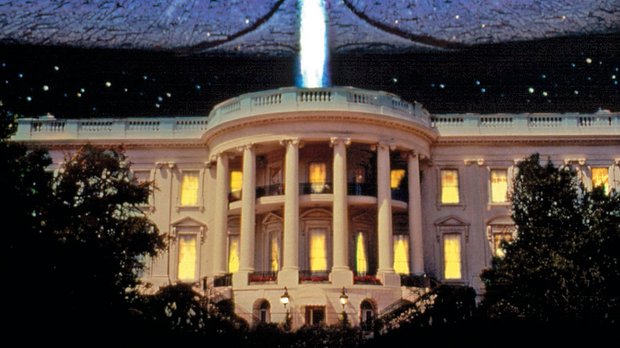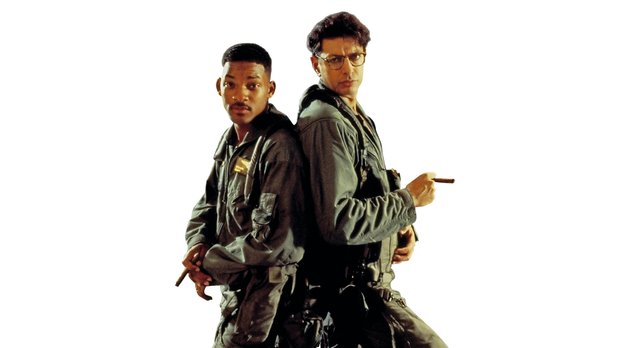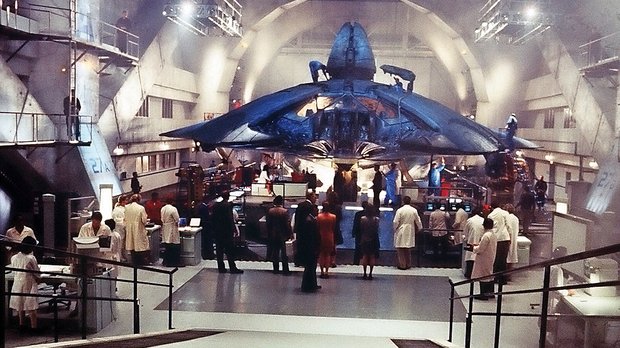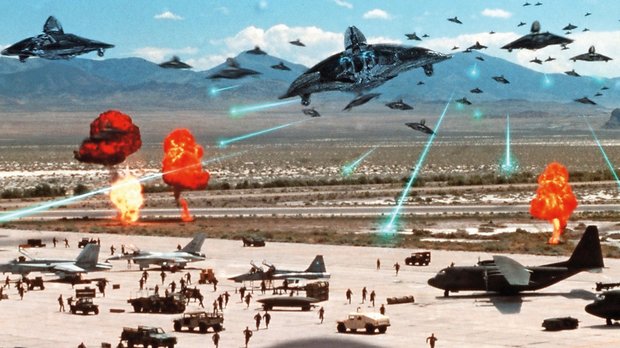Stop us if you’ve heard this one before: otherworldly invaders come to Earth and summarily slaughter its inhabitants but thanks to the efforts of some ambitiously resilient Americans, the aggressive aliens are ousted and harmony is, ultimately, restored. Indeed, on paper 1996’s blockbuster hit Independence Day may as well have been called War Of The Worlds Part II. Yet, when the Roland Emmerich-helmed fantasy romp rolled around, the big screen had been decidedly lacking in any super-sized sci-fi shocks. Oh sure, Independence Day may not have been anything original in the eyes of the more seasoned genre buff but, given that 1995’s biggest hits included Apollo 13, Braveheart and Die Hard With A Vengeance is it any wonder that audiences lined up around the block to see some space-nasties destroy the White House? In fact they're set to do so again in 2016 for the sequel, Independence Day: Resurgence.

Yet, despite going on to be the biggest grossing movie of the year, Independence Day was considered to be a very risky investment by its studio, Twentieth Century Fox. So much so, in fact, that the extraterrestrial epic was only given the green light after Emmerich, and writer-producer Dean Devlin, proposed to drastically cut costs. “We were under severe budget constraints with that movie,” begins Douglas Smith, the visual effects wizard who would go on to win an Oscar for his work on Independence Day and whose CV includes Star Wars (1977), Lifeforce (1985) and True Lies (1994). “What happened is that Roland promised he could get the film done for a price which didn’t frighten away the studio. I think it was about $60 million, which meant that this was not going to be the most expensive feature ever made. Of course, that sounds like a lot of money, and it is, but in comparison to other major summer movies – and considering what needed to be done – it was really not enough. For instance, they were planning to do all of these extensive visual effects but it had to be cost effective.”
The question is, then, why Emmerich – then scaling the heights of Hollywood after the success of 1994’s Stargate – was so willing to instigate Independence Day on a less-than-stellar cash flow… “The answer to that is simple,” admits Smith. “Basically, by agreeing to stick to that budget the studio allowed him to have some independence of his own, if you will pardon the pun [laughs]. So we were moving ahead even though, internally, the numbers were just not working out. In short – what we were supposed to spend, and what we were spending, was not the same thing.” Consequently, Smith found himself diving headfirst into a project which he now considers to be the most challenging of his entire career.

“The movie was a very difficult experience for me,” he reflects. “It turned out to be one of the most successful projects that I worked on – right up there with the original Star Wars – but it was also one of the most difficult. To give you an idea: it was about midway through the shoot when the first visual effect shot got put together and edited. I was sitting there watching it and thinking, ‘Oh no, this is just not working out.’ It was so bad that I was saying to myself, ‘I have to show my friends this’ [laughs]. It was embarrassing, you know? So I was concerned about whether or not Independence Day was going to work as sheer spectacle or not.”
Thankfully, Emmerich eventually found a way to find some further support from Fox and some fresh financing soon resulted. “What happened is that we compiled a showreel,” Smith tells SFX. “That was what really cemented the confidence of the studio. I am not sure what the final budget tally of the movie was but I don’t think they had to spend all that much more. We also screened the showreel to some exhibitors and it was very well received. If I recall, they alluded to Jurassic Park and thought this could be just as big. I remember that Roland came back and said there were now huge expectations for the movie. After that it was a case of ‘Just shoot and do whatever you need to do to make it work out.’ So we made up some new storyboards, and this was only four weeks before the release of the film [laughs]. It was that tight to get everything right. It was a really crazy experience and it wore me out. As the guy in the middle of it, it was never clear that this movie was going to come out as well as it did.”
Of course, at the box office, where Hollywood pays most of its attention, Independence Day came out very well indeed. In its opening American weekend the feature awed enough audiences to seize over $50 million in theatres. Given that the stars of the film were Will Smith (then still a relatively unproven and unfamiliar leading man), Jeff Goldblum, Bill Pullman and Randy Quaid, it’s safe to say that this fiscal phenomenon had more to do with the onscreen special effects – and that ominous poster image of the White House being destroyed – than any particular thespian-appeal.
“That might be true to an extent but there are a lot of special effects movies that cannot sustain themselves emotionally,” admits Smith. “However, Independence Day manages to do that. You become involved with these characters and you really care about them. But, whatever the reasons were, I was over the moon when people flocked to see it. I got an Oscar out of it too which is nothing to complain about [laughs]. Sometimes you sweat blood over a film and it fails financially, or it is dreadful and you just do not want it on your resumé, but thankfully that was not the case here.”
Sign up to the SFX Newsletter
Get sneak previews, exclusive competitions and details of special events each month!

Yet, despite breaking box-office records (including the largest opening week gross in US cinema history), Smith had little opportunity to enjoy his success. “That film taught me everything when it came to learning about my body’s ability to deal with stress,” he laughs. “So when it was finally finished I was happy to kick back and relax for a little bit. There was a big buzz about Independence Day but it was not until I went to a showing at the end of the opening week that I really had the chance to enjoy what we had created. It was a packed screening with a rowdy college crowd and they were ready for this movie. It was totally wild and whenever something crazy would happen I could not hear myself think for about five minutes afterwards because of the cheers. So it was great to be a part of that. Unfortunately, it was also detrimental to me judging the movie itself [laughs]. When I worked on Star Wars someone from ILM came by and let us all know about the box-office records which were being shattered – but with Independence Day I just read about it in the paper. I think everyone was just happy to have it done, and out there, in the end.”
Unfortunately, the critical reception to Independence Day was less than stellar. Sure, several stateside viewers applauded the sight of jingoistic Americans taking the fight to some destructive extraterrestrial terrors, but many reviewers were less than kind. The BBC, for instance, noted the film’s closing, feel-good celebration of United States heroism as being “jaw-droppingly pompous” while a critic at the San Francisco Chronicle singled out Smith’s special effects as one of the few things of merit in what was labelled “derivative” and “cynical”.

“I found the criticism that the movie came under, and which it still gets, really unfair,” affirms Smith in response. “Roland is a great filmmaker with a clear vision. He had ideas for what every last thing should look like – including that big spaceship – and just look at his casting: he was smart enough to see that Will Smith was going to be the next big thing. I think the movie walks a very thin line between farce and success and the reason it never slips is down to his actors. They really knew how to play Independence Day. But above everything else, it’s just a very entertaining film. I heard a radio commentator the other day speaking about it and he said that when Independence Day came out he was hard on it but – looking back on it now – it’s actually a lot of fun. I don’t think the same thing can be said about a lot of the other blockbusters from that era. But Independence Day is standing the test of time and that is attributable to Dean and Roland and their gift as storytellers.”
Almost two decades later, Independence Day is threatening to spawn a series of its own, with Emmerich and Devlin now on record as intending to begin production on a sequel. Questioned about this Smith mentions that he would be willing to jump onboard for another alien ass-kicking adventure…
“I am not surprised that the second film has taken so long to get going,” he states. “When we finished Independence Day I recall Roland telling us, ‘I want lots of destruction in this movie so that there is no chance of a follow-up movie’ – which makes me laugh now. Of course, even after all of the money that Independence Day took at the theatres, Roland did not want to do a part two unless there was a really good story. Now, I believe that they have that, and that is probably why they are moving forward. So, yes, I have been hearing about it but I don’t know where it stands. Independence Day took up a year of my life but it was also extremely rewarding so, if I was asked, there is no question that I would love to do the sequel.”

Certainly, in this post-9/11 world, the sight of major American landmarks being lacerated may cause understandable distress to indigenous audiences. On the other hand, perhaps some alien-escapism is just the sort of fantasy-formula that will capture an all-new austerity-generation audience. The answer, as the old saying goes, is in the stars…
Click here for more excellent SFX articles. Or maybe you want to take advantage of some great offers on magazine subscriptions? You can find them here
Images © REX FEATURES (5), KOBAL COLLECTION
SFX Magazine is the world's number one sci-fi, fantasy, and horror magazine published by Future PLC. Established in 1995, SFX Magazine prides itself on writing for its fans, welcoming geeks, collectors, and aficionados into its readership for over 25 years. Covering films, TV shows, books, comics, games, merch, and more, SFX Magazine is published every month. If you love it, chances are we do too and you'll find it in SFX.


